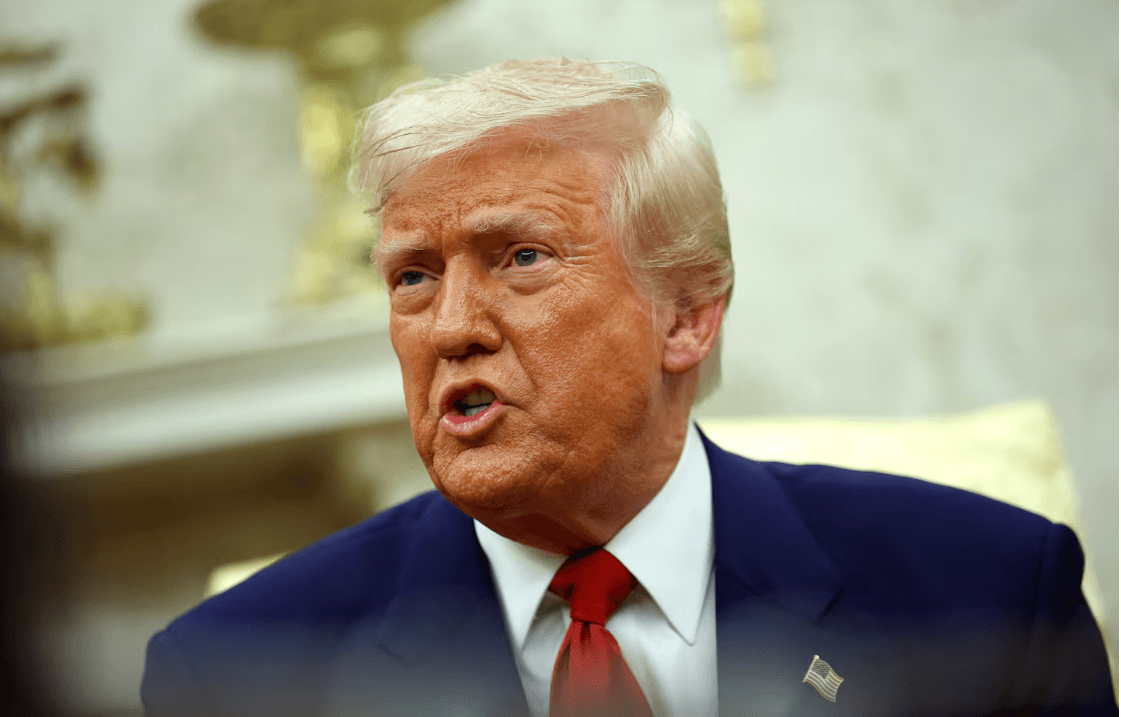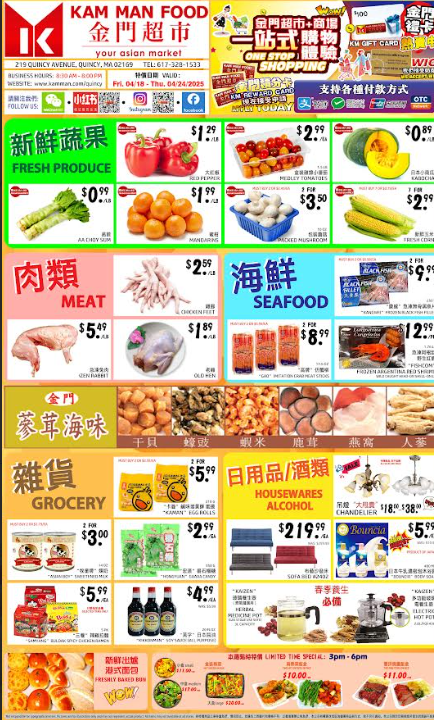特朗普表示不会暂停征收关税,但他将针对中国进行报复

【中美创新时报2025 年 4 月 8 日编译讯】(记者温友平编译)唐纳德·特朗普总统周一表示,他不打算暂停本周晚些时候生效的一系列扩大关税,同时他威胁对中国进口产品征收高达 104% 的关税,以抵御北京和其他大国的报复。《纽约时报》记者托尼·罗姆和安娜·斯旺森对此作了下述报道。
特朗普发出警告的当天,白宫再次因不断升级的全球贸易战而陷入守势。但总统坚称,他不会屈服于越来越多的政府请求救助,也不会屈服于市场因混乱和困惑而再次动荡的局面。
当被问及暂停征收关税的可能性时,特朗普表示:“我们不会考虑这个。我们只有一次机会,其他总统不会像我一样这么做。”
特朗普当天首先就所谓的互惠关税划定了新的战线,他计划在周三午夜后对某些国家征收这些关税。这些关税对某些国家最高可达 46%,几天前,特朗普刚刚对几乎所有美国贸易伙伴征收了最低 10% 的关税,而几天后,这些关税将立即生效。
特朗普特别针对中国,中国上周宣布将对美国进口产品征收 34% 的报复性关税,以对抗美国。特朗普在 Truth Social 上发帖,要求北京撤销报复措施,否则将从周三开始面临美国额外 50% 的关税。他还威胁要停止任何进一步的谈判。
此次升级可能使美国对中国商品征收的关税达到 104%,不过对于某些产品而言,由于早在特朗普第一任期内就已征收关税,税率可能会更高。总而言之,这可能会让从中国进口服装、手机、化学品和机械的进口商付出高昂代价。去年,美国消费者从中国购买了价值 4400 亿美元的商品,中国成为仅次于墨西哥的美国第二大进口来源国。
特朗普向中国发出最后通牒的同时,还承诺如果其他美国贸易伙伴也试图抵制他的政策,美国将对其征收惩罚性额外关税。但他的攻击似乎并没有阻止包括欧盟在内的一些反对者,欧盟官员准备发布一份美国产品清单,这些产品可能很快会遭到报复。
随着全球紧张局势加剧,特朗普的策略再次引发华尔街的不安情绪。标准普尔 500 指数下跌 0.2%,目前比 2 月中旬的峰值低近 18%。科技股占比较高的纳斯达克综合指数全天也经历了剧烈波动,但最终小幅收高。
投资者对关税感到沮丧,当天早些时候的一则错误新闻报道称总统可能会暂停贸易战,这引发了股市的立即上涨——然而,在白宫明确表示不会暂停贸易战后,股市又迅速暴跌。
尽管如此,政府官员似乎仍为最终化解贸易战的谈判留下了空间,理由是最近几天有 50 多个国家(包括最近的以色列、日本和越南)与美国政府接洽,希望达成协议。在白宫会见总统后,以色列总理本雅明·内塔尼亚胡周一承诺,以色列将“消除与美国的贸易逆差”,同时“相当快地”减少其他贸易壁垒。
但白宫官员试图为总统愿意接受的条件设定一个高标准,这标志着特朗普及其助手最初表示不会就关税问题讨价还价后,白宫基调发生了转变。
白宫国家经济委员会主任凯文·哈塞特在接受福克斯新闻采访时表示:“如果他们向我们提出真正有利于美国制造业和美国农民的优惠条件,我相信他会听取的。”
哈塞特表示,一些国家已提出“一些很棒的协议”,但他补充说,特朗普“数十年来一直虐待美国工人,要让他真正决定坐到谈判桌上并在协议上签字将会非常困难”。
白宫高级贸易顾问彼得·纳瓦罗 (Peter Navarro) 特别指出,其他国家需要做的不仅仅是降低自己的关税,才能从美国获得救济。他在 CNBC 节目中表示,需要减少“欺骗”行为和其他限制美国商品进入国外市场的壁垒。
白宫经济顾问委员会主席斯蒂芬·米兰表示,外国的提议“将受到美国欢迎”。他在华盛顿的一次活动中补充说,总统“非常清楚,我们希望增加进入外国市场的渠道,以促进我们的出口。”
贸易战似乎看不到尽头,经济学家们再次不得不面对这样的前景:高关税可能会提高消费者的价格,减缓美国经济增长,并使美国陷入衰退。关税是对进口商品征收的税,企业可能难以承受,这可能会导致这些企业将新成本转嫁给消费者。
玩具公司 Basic Fun 的首席执行官杰伊·福尔曼称总统对中国的新威胁“毫无根据”。
福尔曼表示,他刚刚全面暂停从亚洲发货的所有产品。“我不能冒险将任何产品投放到可能产生 54% 至 104% 关税的海域,”他说。“试图吸收或转嫁 10% 至 20% 的关税是一回事,但 54% 至 104% 的关税是不可能的。消费者会停止消费。”
本文最初刊登于《纽约时报》。
题图:特朗普总统。Kevin Dietsch/Getty
原英文报道:
Trump says no pause to tariffs as he targets China for retaliation
By Tony Romm and Ana Swanson New York Times,Updated April 8, 2025, 2:32 a.m.
President Trump.Kevin Dietsch/Getty
WASHINGTON — President Donald Trump said Monday that he does not plan to pause a slate of expansive tariffs set to take effect later this week, as he threatened to subject Chinese imports to a staggering 104% tax in a bid to ward off retaliation by Beijing and other powers.
Trump issued his warning on a day when the White House once again found itself on the defensive for its spiraling global trade war. But the president insisted he remained unbowed by the widening range of governments pleading for relief and the markets convulsing anew over the chaos and confusion.
“We’re not looking at that,” Trump said, when asked about a possible pause on his tariffs. “We’re going to have one shot at this and no other president is going to do what I’m doing.”
Trump began the day by drawing new battle lines over his so-called reciprocal tariffs, which he plans to impose on certain countries after midnight Wednesday. The taxes, which can reach as high as 46% for some nations, will snap into effect just days after the president imposed a minimum 10% levy on nearly every U.S. trading partner.
Trump specifically targeted China, which announced last week that it would match the United States by imposing a retaliatory 34% tax on imports from the U.S. In a post on Truth Social, the president demanded that Beijing rescind its retribution or face an additional 50% U.S. tariff beginning Wednesday. He also threatened to halt any further negotiations.
The escalation could bring the U.S. tariff on Chinese goods to 104%, though for some products, the rate is likely to be much higher because of levies that date back to Trump’s first term. Taken together, it could prove costly for importers bringing in clothing, cellphones, chemicals and machinery from China. American consumers last year bought $440 billion of goods from China, making it the second-largest source of U.S. imports after Mexico.
Trump coupled his ultimatum to China with a pledge to issue punishing, additional tariffs on other U.S. trading partners if they similarly try to rebuff his policies. But his attacks did not appear to dissuade some opponents, including the European Union, where officials prepared to circulate a list of U.S. products that they could soon subject to retaliation.
With global tensions rising, Trump’s strategy triggered another day of unease on Wall Street. The S&P 500 fell 0.2%, now almost 18% below its mid-February peak. The tech-heavy Nasdaq composite index, which also saw dramatic swings throughout the day, ended slightly higher.
In a sign of investor frustration over the tariffs, an erroneous news report earlier in the day, suggesting that the president might pause his trade war, sparked an immediate rally — only to see stocks just as quickly plummet again, after the White House made clear no such pause was in the offing.
Still, administration officials appeared to leave open the door for negotiations that could ultimately defuse the trade war, citing the fact that more than 50 countries — including, most recently, Israel, Japan and Vietnam — had approached the U.S. government in recent days to strike deals. After visiting with the president at the White House, Israeli Prime Minister Benjamin Netanyahu pledged Monday that his country would “eliminate the trade deficit with the United States,” while reducing other trade barriers “fairly quickly.”
But White House officials have sought to set a high bar for what the president is willing to accept, marking a shift in tone after Trump and his aides initially signaled they would not haggle over tariffs at all.
“If they come to us with really great deals that advantage American manufacturing and American farmers, I’m sure he’ll listen,” Kevin Hassett, the director of the White House National Economic Council, said in an interview on Fox News.
Hassett said some nations had proposed “some deals that are great,” but added of the president: “After decades and decades of mistreating American workers, it’s going to be tough to get him to decide to really come to the table and sign on the dotted line.”
Peter Navarro, a senior White House trade adviser, specifically said that other nations needed to do more than lower their own tariffs to secure relief from the United States. Appearing on CNBC, he cited a need to reduce “cheating” and other barriers that restrict American goods in foreign markets.
And Stephen Miran, the head of the White House Council of Economic Advisers, said offers by foreign countries “would be welcomed by the United States.” He added at an event in Washington that the president had been “very clear that we want increased access to foreign markets that would boost our exports.”
With seemingly no end to the trade war in sight, economists once again were left to grapple with the prospect that high tariffs could raise prices on consumers, slow U.S. growth and tip the country into a recession. Tariffs are taxes on imports, which businesses may struggle to afford, potentially resulting in those firms passing on the new costs to customers.
Jay Foreman, CEO of toy company Basic Fun, called the president’s new threat against China “unhinged.”
Foreman said he had just initiated a complete hold on all shipments of his products from Asia. “I cannot risk putting any product on the water that might incur, at this point, a 54% to 104% tariff,” he said. “It’s one thing to try to absorb or pass along 10% to 20%, but 54% to 104%, it’s impossible. The consumer will just shut down.”
This article originally appeared in The New York Times.

